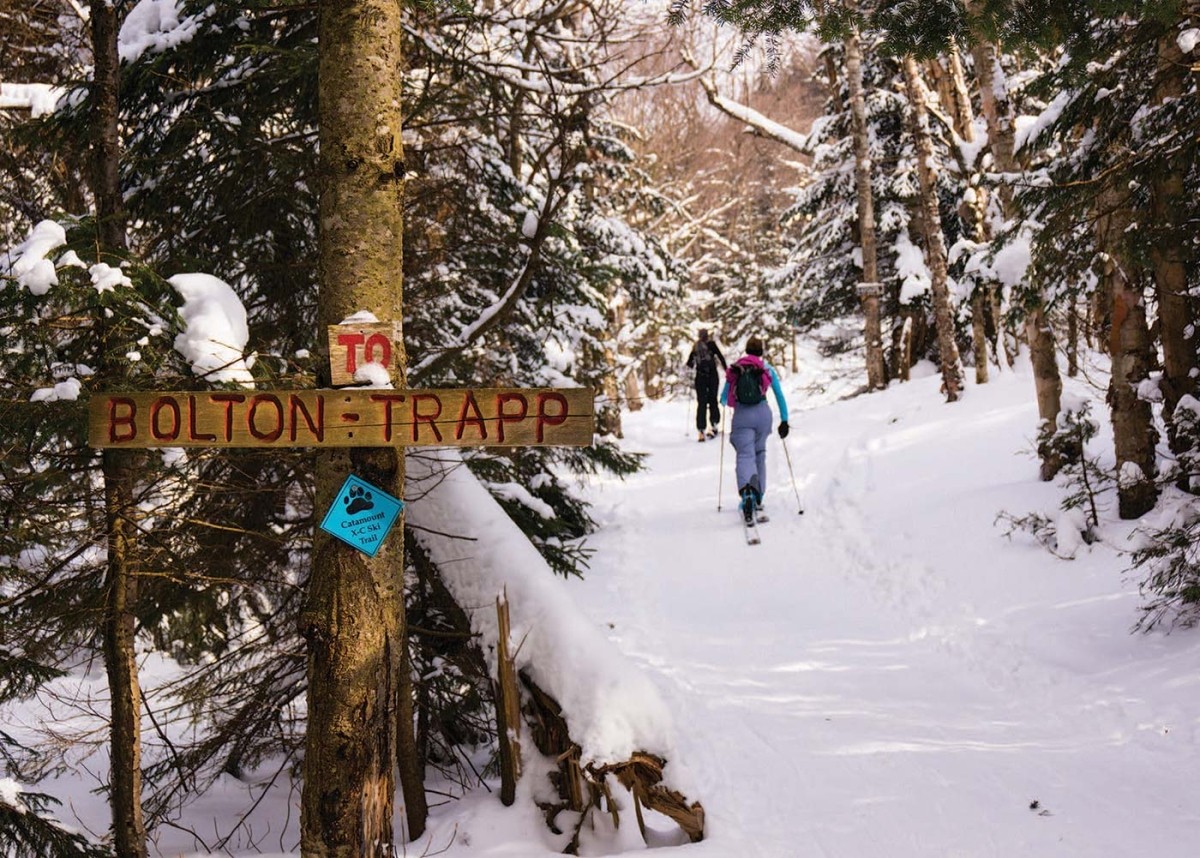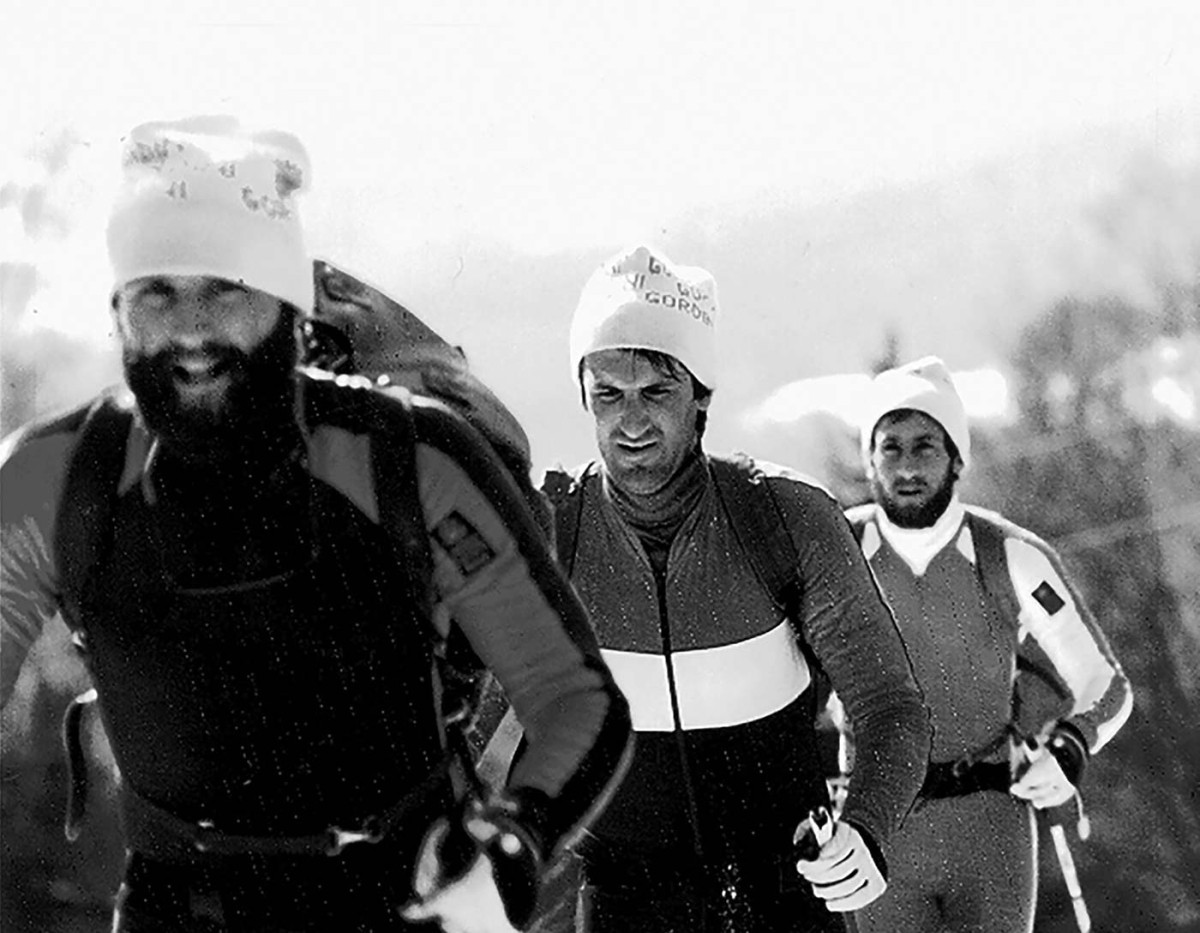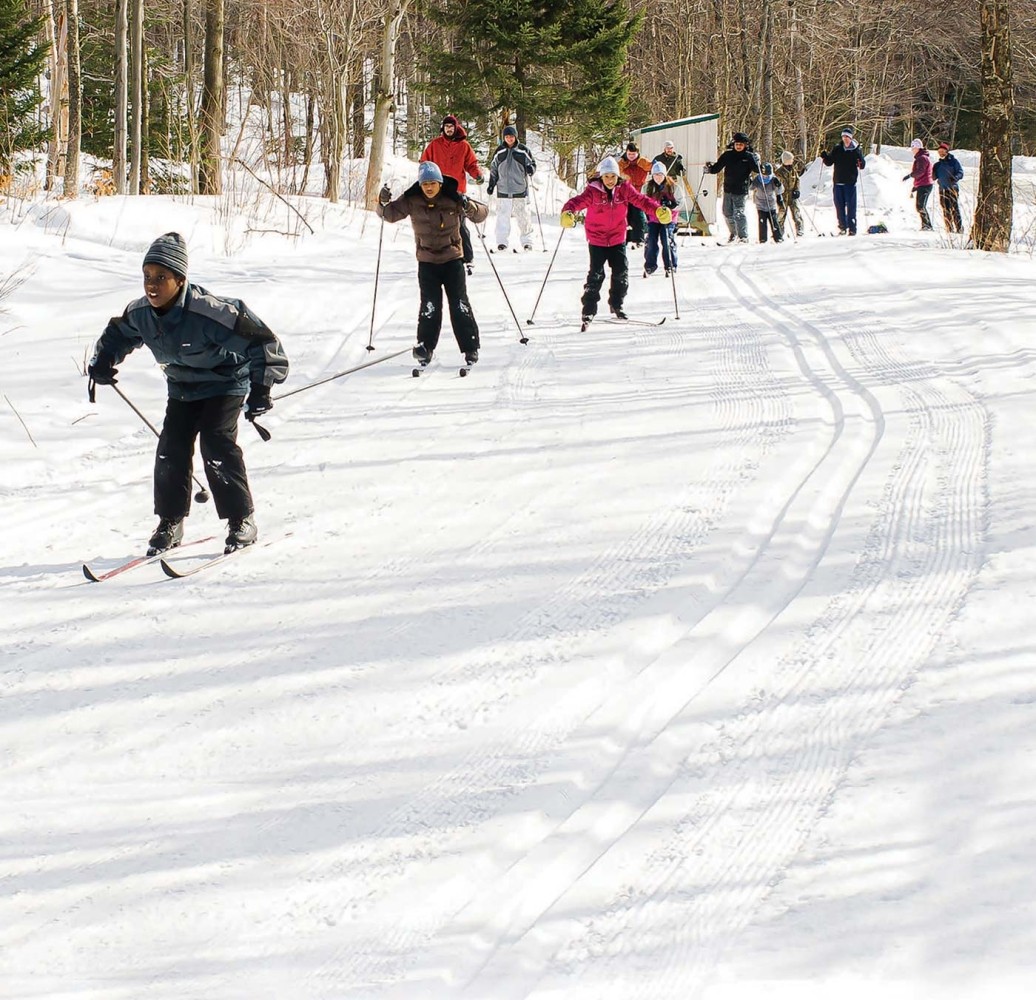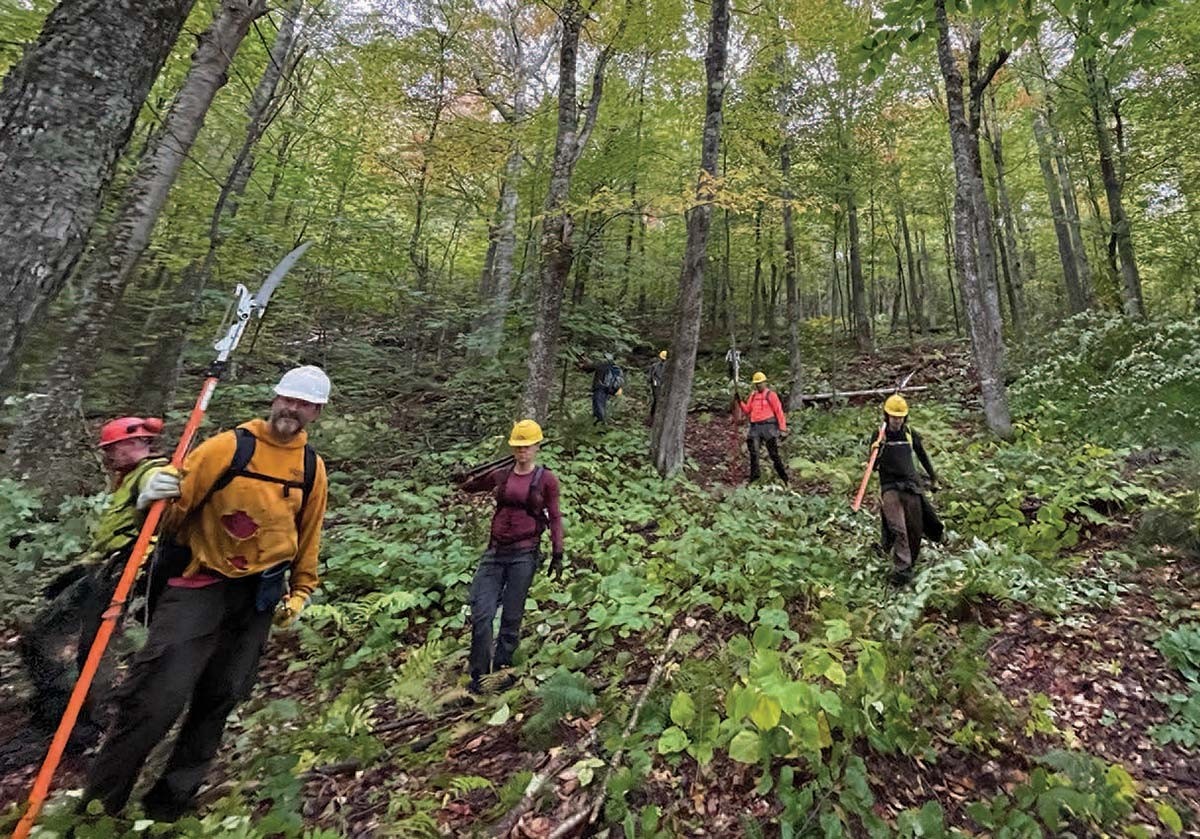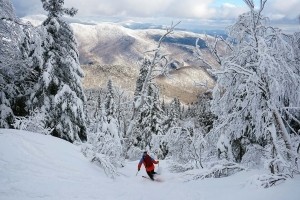
The mystique of the Catamount Trail (CT) lured me to Vermont in the 1980s. I was living in Boston and had heard of the new 300-mile trail that traveled the length of the Green Mountains, from the Massachusetts border to the edge of Quebec. The mere idea of this trail intrigued me. Long-distance trails seemed a notion of a bygone era: In 1910, James P. Taylor, founding president of the Green Mountain Club, had envisioned Vermont’s Long Trail, a 272-mile footpath that follows the ridges of the Green Mountains; a decade later, Benton MacKaye, a planner, forester, and social reformer, proposed the idea of the Appalachian Trail, snaking along some 2,000 miles from Georgia to Maine. Six decades later, it seemed we were at the awn of a new era – this time, for a long-distance ski trail.
One particular section of the Catamount Trail caught my eye: the 9.4 miles that traversed the backcountry between Bolton Valley ski area and Trapp Family Lodge. It linked two storied ski centers and crossed the heart of Vermont ski country. In 1987, I traveled north with friends to explore this new skiing marvel.
Soon after we began climbing uphill from Bolton Valley, I was breaking trail in knee-deep powder. We traversed the side of Bolton Mountain, then dropped into the Nebraska Valley. Feathery flakes boiled up over my waist as I dipped down to carve telemark turns on the blank, white canvas. A few tumbles left me plastered in snow. Arriving hours later at the elegant Trapp Family Lodge after an exhilarating tour through the Vermont outback, my partners and I were tired, satiated, and happy for a warm drink.
A Ski Dream Is Born
The Catamount Trail was the vision of three Vermont friends who first skied the route in 1984. From the start, Steve Bushey, Ben Rose, and Paul Jarris – a trio of adventure-seeking 20-somethings – wanted this trail to reach beyond skiing. Their project was as much about building community as it was about finding the next sweet turn.
Bushey, a geography major at the University of Vermont, and Rose, a recent Yale graduate, were friends from high school and had recently biked across the country together. They were searching for their next adventure. Jarris, who had been a classmate and regular adventure partner of Bushey at UVM, was a fourth-year medical student at the University of Pennsylvania.
Following graduation from UVM in 1981, Bushey got a job as a mason in Charlotte, Vermont. While working on a roof, he gazed at the undulating ridgeline of the Green Mountains and thought, Why not ski the length of Vermont?
Today, he acknowledges this was a crazy idea. “The great thing of chasing something when you’re 22 or 23 years old, you don’t think of all the labor and misery and cost,” he told me when we spoke this year. “You just think about the dream.”
Bushey continued to ruminate. “I began trying to put together the pieces of a puzzle. The Long Trail was a mentor, a pattern. But as a geographer I needed to find out where all the trails were,” he said. In 1982, Bushey got a job with Northern Cartographic to write a cross-country ski atlas of Vermont. “That gave me the opportunity to collect lots of maps and visit ski centers from north to south. That was kind of the fieldwork.” He subsequently pursed a master’s degree in geography at Carleton University in Ottawa. For his master’s thesis, he created a route for an end-to-end ski trail in Vermont.
In 1984, Bushey recruited his old friends Rose and Jarris to spend three weeks skiing across Vermont, linking inns and cross-country ski centers that they had contacted in advance for help with their mission. They incorporated the nonprofit Catamount Trail Association (CTA) the day before they began skiing in order to share and sustain the excitement around the idea of the trail. When the trio set off on March 1, 1984, they were not just skiers – they were evangelists. “We could be out there skiing and meeting people, selling this idea of this Long Trail for skiers that we had dubbed the Catamount Trail,” said Bushey. “We collected our first members as we were skiing.”
Four decades later, the Catamount Trail is now what Vermont Commissioner of Forest, Parks & Recreation Michael Snyder calls “the backbone, literally and figuratively, of cross-country skiing in Vermont, which has put us on the map for end-to-end skiing.”
As an organization, the CTA is equally important. “I couldn’t overstate the importance of what the CTA has done,” Snyder said. “It’s a key element in the re-emergence of backcountry skiing in the state.”
A Backcountry Evolution
In recent years, backcountry skiing – loosely defined as skiing ungroomed terrain that is typically (but not always) beyond the boundaries of established ski centers – has evolved, and the CTA has had to adapt. During the past decade, a grassroots skiing movement has emerged to create managed glade zones for downhill-oriented backcountry skiing. Part of the impetus has been to rein in unsanctioned rogue glading, in which saw-wielding skiers cut down trees without owner permission or respect for forest stewardship goals.
“It becomes a tragedy of commons, and [the shared resource] breaks,” said Snyder. “It’s not sustainable. It was part of [skiing’s] past but it cannot be part of our future – or we won’t have a future.”
In 2013, a group of skiers formed what is now called the Ridgeline Outdoor Collective (originally Rochester/Randolph Area Sports Trails Alliance, or RASTA), with the goal of working with public land managers to create glades and approved backcountry ski zones. In 2014, ROC and the Green Mountain National Forest forged a first-in-the-nation partnership for a pilot project to cut and manage glade zones – areas where trees are thinned to create downhill ski routes.
“That was a breakthrough,” said Tyler Ray, who was inspired by ROC to found Granite Backcountry Alliance in New Hampshire and western Maine. “It’s no secret that glading has been going on for a long time. Now it’s above board and people are doing it collectively and there’s an excitement to that.”
In 2014, ROC sponsored a backcountry skiing forum attended by several hundred skiers. Trails organizations are often singularly focused on stewardship of one trail. But backcountry skiers were growing in number and pushing boundaries of the sport well beyond the Catamount Trail corridor – and beyond the role CTA had played since its formation 30 years earlier. CTA adapted by taking on the role of umbrella organization for a growing number of community-based backcountry ski groups. In 2014, ROC became the first chapter of CTA. There are now six chapters throughout Vermont, from the Southern Vermont Trails Association at one end of the state to the Northeast Kingdom Backcountry Coalition (NEKBC) at the other.
“We have to be more than we used to be. There are just so many more people skiing and in the woods,” said CTA Executive Director Matt Williams. “Community-based skiing is a continuation of what the Catamount Trail has always been about. It is a contiguous entity but it’s really a collection of pockets of ski culture.”
Angus McCusker, ROC’s executive director, said joining forces with CTA “has been fantastic. They had 30-plus years’ experience working with landowners who already trusted CTA. We were an entirely new organization and that helped us establish relationships with land managers and the U.S. Forest Service.”
The Catamount Trail Association is now a leader in the burgeoning grassroots backcountry ski movement. “The CTA is a national model,” said Todd Walton, executive director of Winter Wildlands Alliance, an organization that represents more than 100 environmental and grassroots ski groups around the country. “They do a lot of work not only in stewardship, but also in advocacy and policy issues on the local, regional, and national level for what the positivity of trails can do, not only in backcountry zones.
“In the Northeast,” Walton continued, “you have this really interesting partnership between private and public landowners. That doesn’t necessarily happen in the big western states. CTA has been an example of how to successfully work with the policymakers and landowners and land managers.”
Growing Pains – and Gains
“Backcountry skiing has been the only growth category in skiing for the last 6 to 8 years, and it’s been rising in double digits for several years,” said Walton, adding that the growth of the sport has been accelerated by the Covid-19 pandemic. In the fall of 2020, outdoor retailer REI reported that sales of backcountry ski equipment had tripled in just one year.
Usage of the Catamount Trail has reflected this surge. The number of skiers on the Bolton-Trapp Trail – that segment of the fledgling CT I first skied in the 1980s – more than doubled from 2018 to 2020. A typical Saturday will see around 70 skiers on this section, with peak days approaching 200 skiers. In the Brandon Gap glade zones managed by ROC, the number of skiers increased 70 percent between 2017 and 2020.
The Catamount Trail has been an important economic contributor to rural communities. A 2018 economic impact study done by SE Group for the CTA showed that day skiers on the Catamount Trail spend more than $300 per ski party, and more than $1,500 per party when they stay overnight in local accommodations. The study also found that skiers of just the Bolton-Trapp Trail (section 22 of the CT) generated $1.2 million in annual sales, $184,000 in yearly federal, state, and local taxes, and support 20 jobs.
That success, however, has come with challenges. The rise in users has posed problems ranging from inadequate parking to conflicts with landowners. “There are real challenges and strains around community infrastructure,” explained Williams. “As interest and use grows, the onus is on us to do more to support users, support sustainable use of the resources, and do more intensive work with landowners to keep it open.”
Conservation and land stewardship have been cornerstones of the CTA’s work from the start. The organization acquired its first trail easement in 1994. It then set an ambitious goal of permanently protecting the entire 310-mile trail. Working with partners including Vermont Housing & Conservation Board, The Trust for Public Land, Vermont Land Trust, Green Mountain Club, and others, the CTA has completed 45 trail easements and partnered on many public land acquisitions. Today, more than 70 percent of the Catamount Trail is permanently protected.
“I think the Catamount Trail has a bright future,” said Commissioner Snyder, while noting that expanded access should be done thoughtfully. “We have to have a backcountry that maintains its character…that doesn’t turn into a Disneyland version of itself. It’s about backcountry, not just skiing.”
The greatest long-term challenge to the Catamount Trail, however, is one beyond the CTA’s control: the changing climate. A study sponsored by the climate action group Protect Our Winters projects that the average number of days with snow cover in New England will decline by 50 to 75 percent in the coming decades, depending on greenhouse gas emissions. Other studies forecast that most ski areas in southern New England will be out of business by 2040, and there will not be skiing anywhere in New England by the end of the century.
“You can only do so much trail maintenance without snow,” said Greg Maino, longtime director of communications for CTA. “We are looking for ways to improve our backcountry zones to the point where they can be skied with as little snow as possible.”
CT co-founder Steve Bushey noted that “the climate is pushing the trail uphill” into the snowier zones. He thinks the CTA’s embrace of higher-elevation glade skiing makes sense both recreationally and as a response to climate change.
Bushey reflected on how far the Catamount Trail has come since he and his friends pushed off at a trailhead four decades ago. “I find it really remarkable that it has not only fulfilled the original vision of an end-to-end trail, but it’s grown way beyond that in terms of creating a community and network of Vermont skiers and outdoors people and land conservationists.”
With a laugh, he added, “We thought this might be a long shot, but it was worth going to the game to play. It captured the interest of a huge number of people, and it paid off. People joined up, put their shoulder to the wheel, and pushed that big boulder to the top of the hill.”
The Catamount Trail that lured me north some 35 years ago is now just minutes from where I live. It is a familiar place, but each time I return, it feels new and exciting.
One morning, I pull into the trailhead to find skiers chatting, laughing, and skinning their skis. As quickly as they appear, they disappear up the trail following the distinctive blue cat’s paw blazes of the CT.
I slide up the trail and soon branch off to a favorite glade. Other skiers have vanished into their own snowy worlds. The woods are teeming with explorers, but I am embraced by the solitude. I peer down from the top of a beautiful hardwood grove. Ribbons of white lace the woods. A path that I have never seen before beckons. I glide forward, accompanied only by the sounds of my breathing and the snow brushing softly against my skis. Cold smoke erupts around me.
The mystique of the Catamount Trail grows stronger with every turn.
CTA Youth Programs Blaze a Trail
The young girl had just arrived in Vermont from Tanzania. She was seeing snow for the first time. She was probably wondering what planet her family had just landed on. Her school in Winooski, Vermont, participates in the Catamount Trail Association’s Ski Cubs program, so her friends, who speak Swahili, invited her to go skiing with them.
The Catamount Trail Association has been blazing trails into New American communities and other underserved youth through its Ski Cubs program for a decade. Its youth programs began in 2011 and are based at Bolton Valley Nordic Center and Sleepy Hollow Nordic Center, both near Burlington. The number of participants in Ski Cubs has increased fourfold since 2019. In 2021, a record 1,100 students and community members participated.
CTA Executive Director Matt Williams said the youth programs have become a core part of the organization’s work. “It’s particularly poignant for New American kids who come here from places without winter culture,” he said. “Winter sucks if you’re sitting inside. The chance to get outside and ski, to have fun in the snow with friends, is really impactful. It’s some of the best work we do.”
Courtney Dickerson, CTA’s program manager for youth programs, was with the young Tanzanian girl when she skied for the first time. “She was very hesitant and scared,” Dickerson said, recalling that it took an hour for the girl to muster the courage to put on skis. “Just seeing her experience skiing – that was a powerful moment. And she came back the next week.”
Prior to becoming a program manager, Dickerson oversaw the youth program as an AmeriCorps volunteer. “It is cool to see kids who are…experiencing a Vermont winter for the first time, and we can provide them something fun to do,” she said. “That’s my favorite part: seeing that joy or spark that we can give them through our programming. These are just simple things – taking them out in winter and teaching them to Nordic ski – but that can be really impactful in their first year or two in the U.S.”
Dickerson said the Ski Cubs program also allows students to connect beyond school, and often the participants say their favorite part of the program is making new friends – or just being outside in winter.
“We find that after a student goes through our program, they see that health and fitness activities are not that difficult to do and are fun,” she continued. “I think of this like we are creating the next generation of Nordic skiers throughout Vermont. Hopefully someday we’ll see these students out on the Catamount Trail.”
“Conservation 2.0”: Granite Backcountry Alliance Takes the Baton
Tyler Ray, the founder of Granite Backcountry Alliance (GBA) in New Hampshire and western Maine, grabbed the baton of the grassroots backcountry skiing movement from ROC and the Catamount Trail Association and took off at a sprint. Since its founding in 2016, GBA has spearheaded community glading projects on public and private lands throughout the region. GBA volunteer work weekends now draw hundreds of people to the mountains to cut what they will soon return to ski.
“Something that GBA has done really well is to collaborate with the CTA and then be able to shake the snow globe and run forward much faster because of the hard work that CTA put in,” said Todd Walton of Winter Wildlands Alliance, which includes both CTA and GBA as members.
Ray is the Johnny Appleseed of backcountry glade zones, spreading them everywhere he goes. GIMBY – Glade in My Backyard – has become GBA’s clarion call. Ray, an attorney who runs Backyard Concept, LLC, a legal and outdoor advocacy organization in North Conway, New Hampshire, said collaboration – including with conservation groups – is key to GBA’s approach.
“Conservation is a great concept, but it’s a concept that’s been sold to an older generation but has not necessarily sold to a younger generation,” Ray said. When conservation groups and land trusts partner with GBA, they tap into “a strong youthful portion of our organization that gives these other organizations visibility. They can then spread their message in more effective and more modern ways. So conservation merges into recreation where it makes sense.
“It’s an exciting time to be in outdoor recreation. It’s essentially Conservation 2.0: People want to get outside, and the places to do it are on conserved land, but that requires collaboration between recreation and conservation groups,” Ray added. “If you can enhance support for the land through recreation and conservation, then you are staying out in front of it.
“The big picture is that these collaborative projects are integral to supporting local economies. Because when they learn how to lean on local recreation, they are putting themselves on sustainable footing going forward. It’s a very sustainable structure. It’s a way of life.”
View the accompanying Web Extra photo gallery: The Making of a Ski Glade


